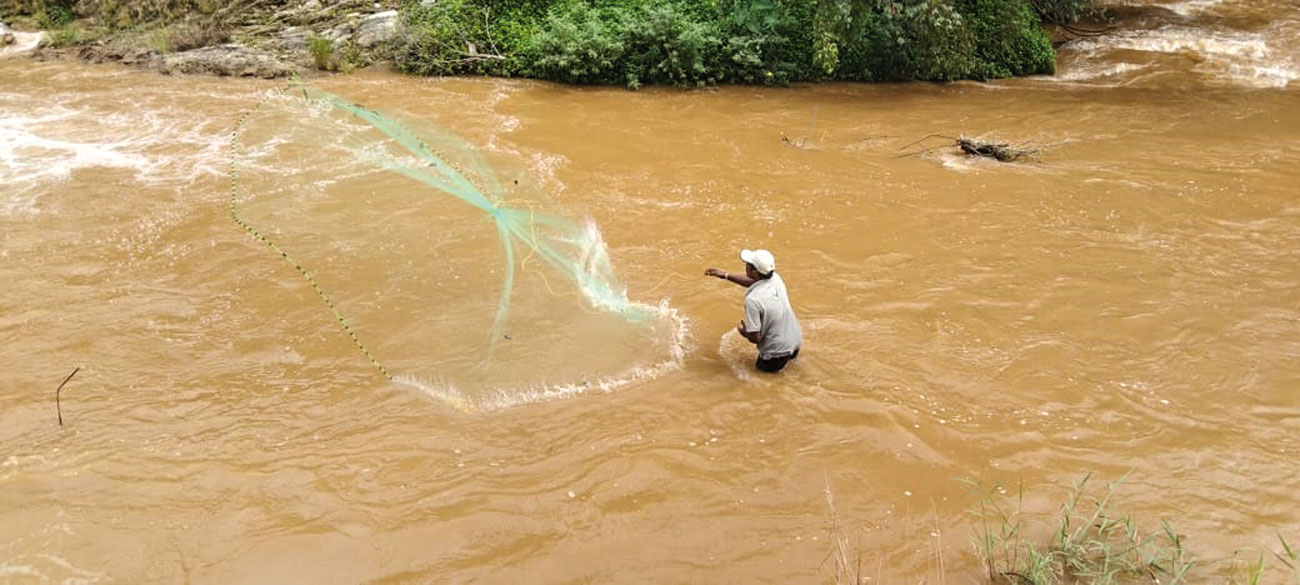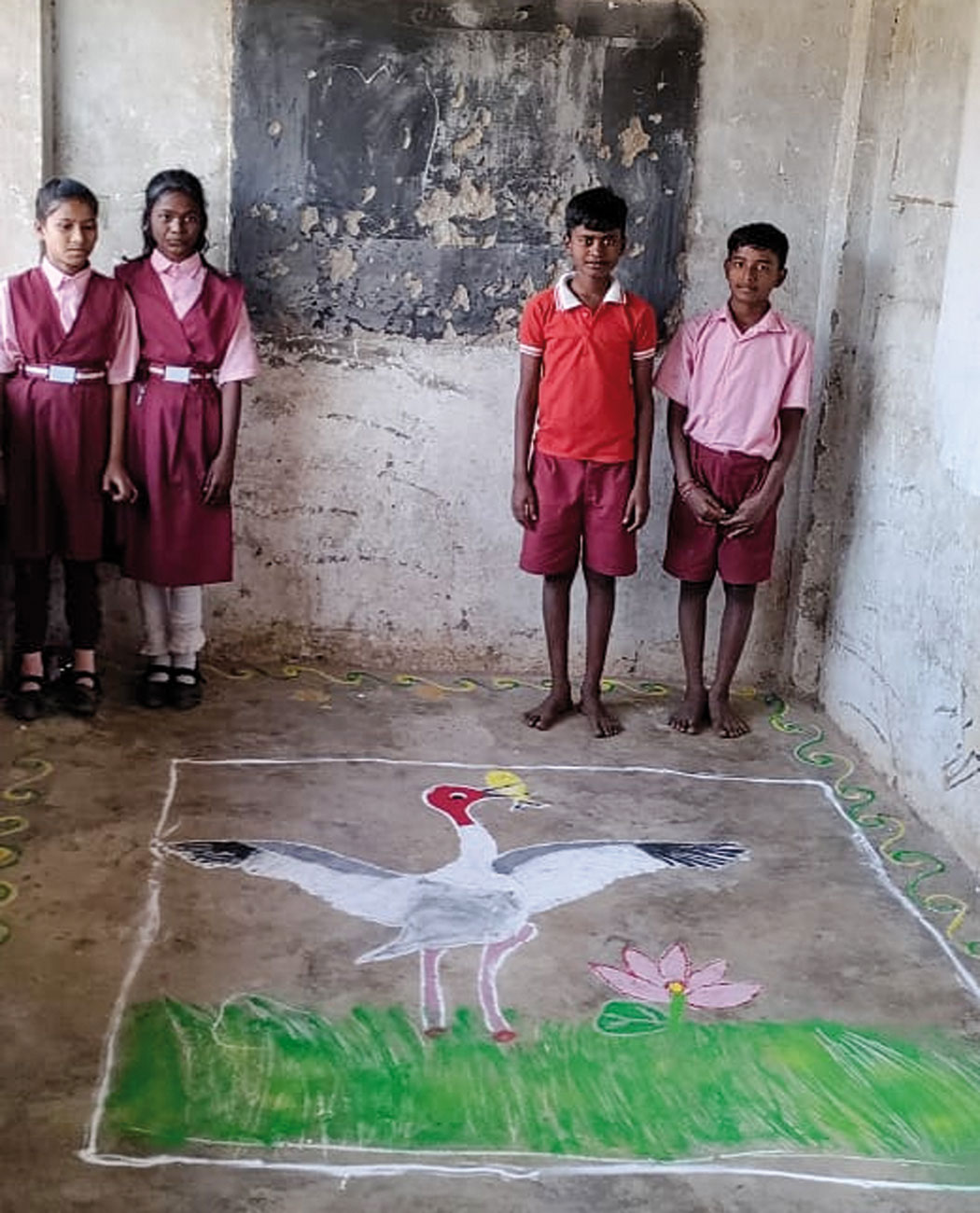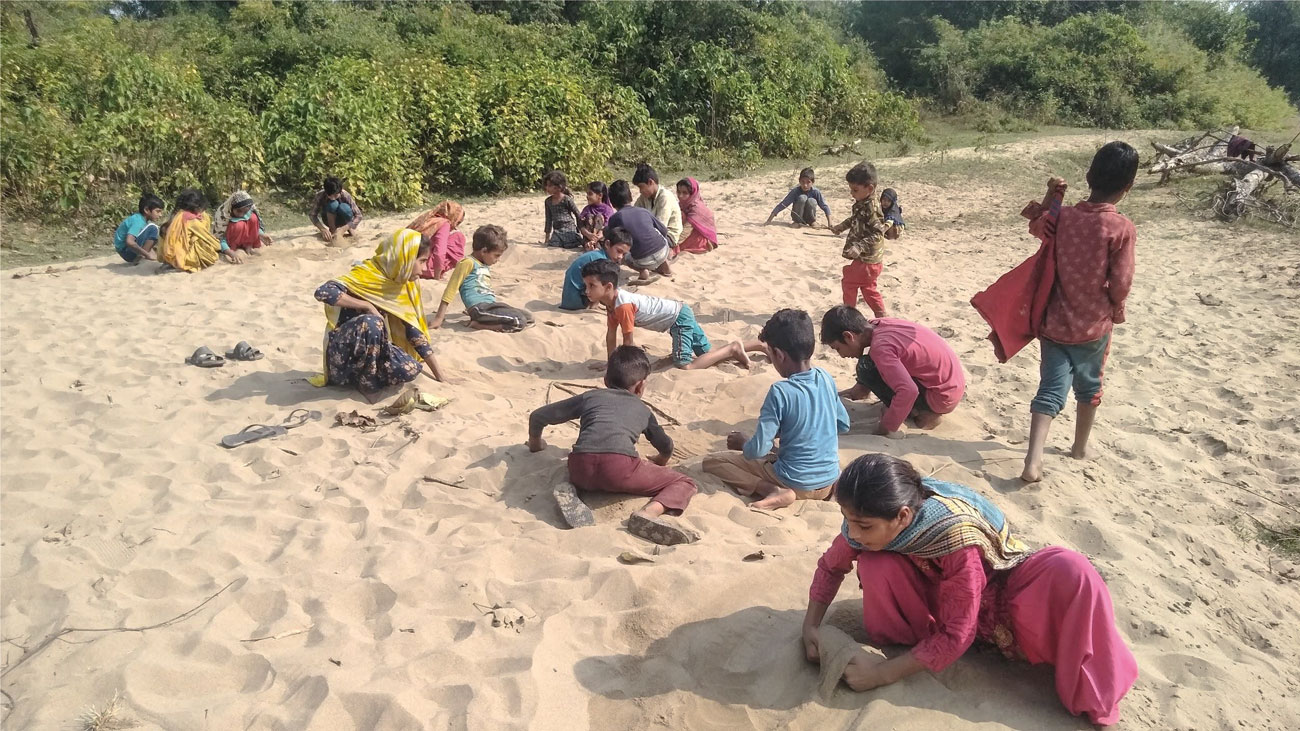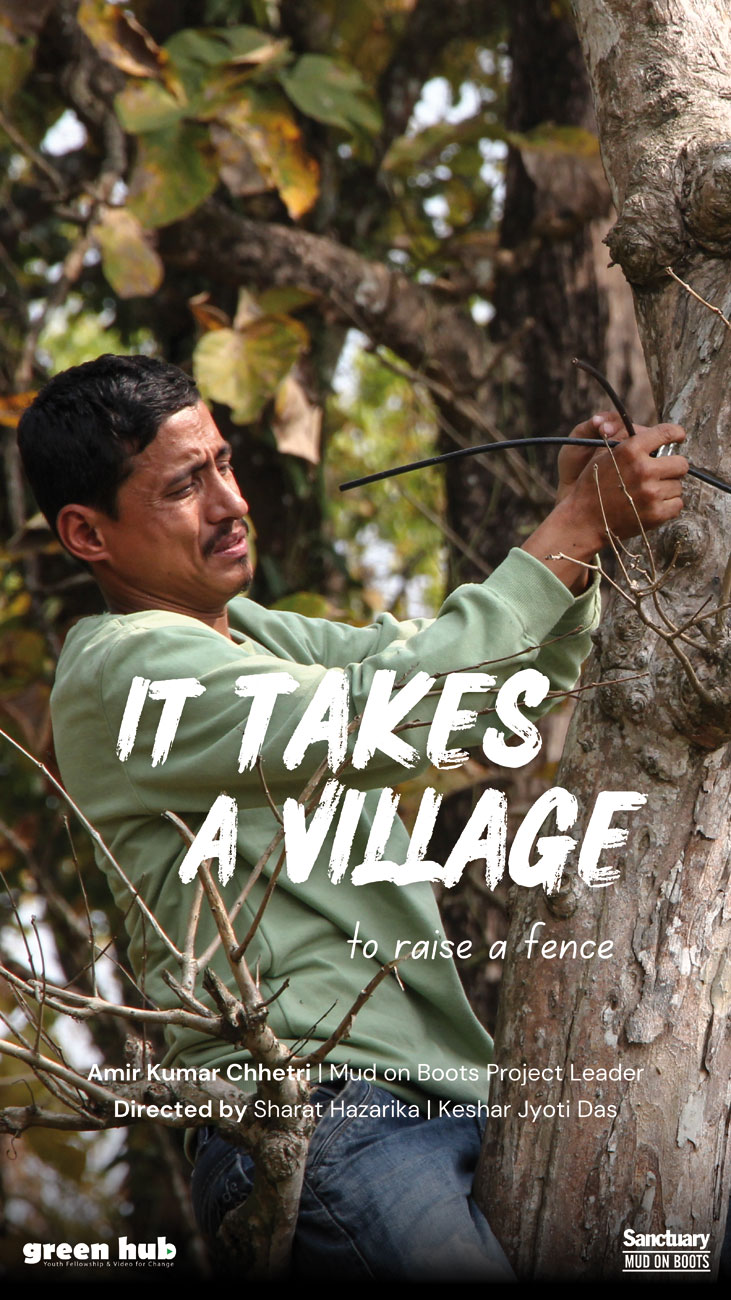Sanctuary’s Mud on Boots: November-December 2023
First published in Sanctuary Asia,
Vol. 44
No. 2,
February 2024
November-December 2023 Report focused on species and habitat recovery across India
Of Mahseer And Man
In November and December 2023, Mud on Boots Project Leader Jesu Das interacted with 200 individuals, including scientists, school children from villages bordering the Cauvery Wildlife Sanctuary, and officers from the Fisheries and Forest Departments of Karnataka, sharing information about the conservation status of indigenous fish in the Cauvery river basin and the conservation efforts that are part of the humpback mahseer recovery project, helmed by associates at the Wildlife Association of South India (WASI). The Deputy Range Forest Officer of Halagur (Cauvery Wildlife Sanctuary) acknowledged his enthusiasm and depth of knowledge exhibited while engaging with school students.

Mud on Boots Project Leader Jesu Das conducting a cast net survey in the Hemavathi river. Photo: WASI.
On December 8, 2023, on invitation by the Deputy Conservator of Forest (Cauvery Wildlife Sanctuary), Das provided inputs on the safe transfer of the humpback mahseer stock – currently housed at the Humpback Mahseer Repository (Bheemeshwari) – to the Harangi Fish Hatchery. Following this, he participated in an expedition surveying indigenous fish species found along the Hemavathi river in the Western Ghats. His skills in fish identification and cast netting were invaluable during this survey, enabling the identification of 26 species of indigenous fish!
Meanwhile, the mahseer stock at Bheemeshwari is stable as Das has independently performed weekly water testing sessions to ensure the same. He also trained a fisherman in the cast netting technique for use in studying fish species, and is now perfecting a PowerPoint presentation he wishes to take to schools in the region to encourage conservation awareness among children.
Ripples Of Change In Gondia
In Maharashtra’s Gondia district, Project Leaders Kanhaiyalal Udapure and Shashank Ladekar collaborated with Paraswara School to organise a two-day Bird Week (November 7 and 8, 2023) celebration to engender an appreciation for local avian diversity among children. On the first day, children found creative expressions of their perspectives and understanding of local birds (including their habitats and diets) through drawing and rangoli-making competitions. The following day, the duo led 80 odd students on a nature and bird walk where seven migratory and 23 resident bird species were sighted and recorded.
Kanhaiyalal and Shashank are working towards reviving the often-defunct biodiversity management committees as part of their long-term goal of wetland conservation in Gondia. In this regard, they conducted four meetings with two biodiversity management committees and understood their composition, capacity, and functioning. Based on the exchanges with attending members of the local community, inputs from Sawan Bahekar (president of SEWA, a local NGO), and drawing on their collective experiences of working for wetland conservation in the region, they suggested crucial changes to the committee representation at Zhilmili and Shivni (two out of the 10 wetlands selected for conservation). As a result, people with long-term information and dependence on wetlands for their livelihood (rozgar sevaks and fisher folk) have now been made core members of the biodiversity management committees!

Students of Paraswara School showcasing their rangoli art depicting a Sarus Crane in a crop field, as part of the two-day Bird Week celebration. Photo: Shashank Ladekar.
Wetlands in Gondia are socio-ecological habitats that house the region’s diverse aquatic flora and avifauna, including the Sarus Crane (an IUCN-designated vulnerable indicator species), and are sources of sustenance and livelihood for locals.
Nature Learning
In Uttarakhand’s Gaindikhata and Gujjar Basti, local children are adept at exploring the region’s mixed forests, grasslands and riverine habitats. Hailing from the resident Gujjar community himself, Project Leader Saddam Husain understands this, and has been conducting nature education sessions to encourage children’s innate curiosity about nature to inculcate the ethos of nature conservation among them.
In October 2023, Saddam attended a nature education workshop by Nature Conservation Foundation-India at the Pakke Tiger Reserve, Arunachal Pradesh, where he learnt new techniques for conducting nature education sessions, and polished his communication and leadership skills. Following this in November and December, he confidently led six nature trails for children using modified versions of the activities he learned at the workshop, including the creation of leaf museums using dead and fallen leaves, ‘Tell Me Why’ rounds where children found answers to questions from their surroundings, learning concepts like pollination through skits, identifying birds and learning about their habitat, diet and migration, and more. Saddam was pleasantly surprised and also encouraged by the creativity and enthusiasm exhibited by the children during the sessions.

Children exploring their environment during a nature education session led by Project Leader Saddam Husain. Photo: Maee.
Saddam, along with his friends at Maee, also continued creating bird checklists, and monitored swamp deer (barasingha) populations at selected points in and around the Jhilmil Jheel Conservation Reserve. His team documented a total of 147 species of birds and 37 barasingha between November and December 2023.
The Power Of Two
In Jharkhand’s Koynardih village, Project Leaders Chamru Bediya and Sahebram Bediya continue to document the local biodiversity and conduct nature education classes for children, while working towards building an eco-tourism model to provide sustainable livelihoods to community members to encourage support for and participation in their long-term nature conservation initiatives.
In November and December 2023, Chamru and Sahebram led five trekking events for 105 guests, earning 25 members of the local community Rs. 45,000 in profits! Avenues of earning cash income in Koynardih are limited and many locals have been resorting to tree felling to make ends meet. Under the mentorship of Rishab Lohia and with support from the Ekastha Foundation, Chamru and Sahebram are working towards creating nature-based livelihood opportunities in Koynardih as part of their sustainable eco-tourism model. They also led three village clean-up drives to boost tourism activities, where 78 members of the local community actively devoted their time. The team is hopeful that economic returns from the eco-tourism endeavour will encourage halting the incidences of forest fires and felling of forest trees.
The duo also led eight nature walks for 46 children, where awareness about nature conservation was shared through tree and leaf identification, games, and nature-themed storytelling sessions. Meanwhile, they recorded 18 tree species, two mammals and five medicinal plants, and made a total of 120 bird count entries on eBird including the Rufous Woodpecker, Pied Kingfisher, and Greater Racket-tailed Drongo, among others.
Other Project-Related Updates
LookEast: A Crowdfunding Campaign
 Photo: Green Hub/Sanctuary Nature Foundation.
Photo: Green Hub/Sanctuary Nature Foundation.
In December 2023, Sanctuary Nature Foundation’s Mud on Boots Project and Dusty Foot Foundation’s Green Hub came together for a crowdfunding campaign, which was designed and led by Cara Tejpal (Founder, The Mud on Boots Project) to support four grassroots conservation initiatives in Northeast India. In 2023, Cara had mentored 20-odd applicants hailing from across Northeast India, who were pitching their innovative community and conservation proposals for the GreenHub Small Grants Programme. Engaging with the participants inspired her to raise financial support for a few invaluable projects that could not make it to the final selection list. In a mere 14 days, the #LookEast Campaign raised over Rs. 20 lakh! The funds will soon be disbursed to enable Nabajyoti Das, Devajit Moran and Trinayan Gogoi, and Yangchin Musabi and Manisha Kumari respectively for human-elephant conflict mitigation in Udalgiri, Assam; wildlife rescue and community engagement around Dehing Patkai, Assam; and creating a children’s storybook based on Indigenous, eco-feminist stories from Arunachal Pradesh. A sum of five lakh rupees will be used by the Mud on Boots Project and Canopy Collective (a sister organisation of Green Hub) to jointly host DEI (Diversity, Equity and Inclusion) workshops for grassroots conservationists from across India.
It Takes a Village
 Photo: Green Hub/Sanctuary Nature Foundation.
Photo: Green Hub/Sanctuary Nature Foundation.
Until October 2021, human-wildlife conflicts were considered inevitable in northern West Bengal’s Panijhora forest village. Crop depredation and property damage were par for the course as elephants, wild pigs and deer entered
the village from nearby forests. With support from the Mud on Boots Project and in collaboration with the Coexistence Project and Voice for Asian Elephant Society, Amir Kumar Chhetri spearheaded a simple but ingenious conservation project of installing solar-powered fences around Panijhora.
Amir involved his village community in the construction and maintenance of the three-kilometre-long solar fence, stopping the movement of wildlife into the village fields. The successful project has been laying the base for human-wildlife coexistence in the region as locals now experience a sense of security and have earned economic profits between six to 10 lakh rupees so far.
The struggles and triumphs of Amir’s journey have been documented by GreenHub’s Sharat Hazarika and Keshar Jyoti Das in a short film titled It Takes a Village. This movie was launched as part of the #LookEast Campaign. With humble beginnings as a safari guide, Amir’s journey is a beacon for coexistence, community-led initiatives, and an inspiration for conservation practitioners!






